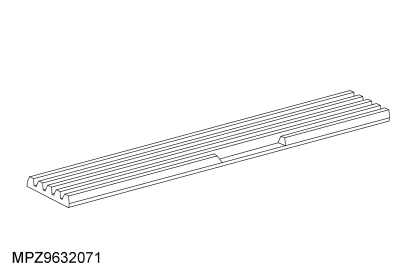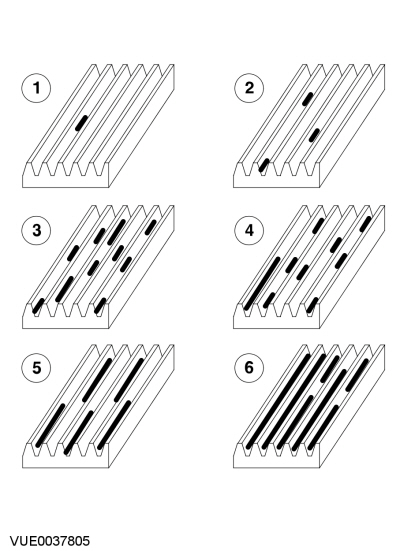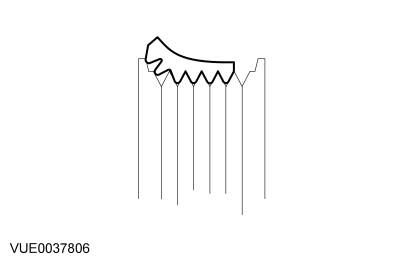| 303-05B Accessory Drive - 1.6L EcoBoost (132kW/180PS) - Sigma
|
2014 Fiesta
|
| Diagnosis and Testing
|
Procedure revision date:
04/3/2013
|
Accessory Drive
Inspection and Verification
-
Verify the customer concern.
-
Visually inspect for obvious signs of mechanical damage.
Visual Inspection Chart
|
Mechanical
|
-
Damaged or contaminated accessory drive belt
-
Damaged or contaminated pulley(s)
-
Damaged tensioner
-
Incorrect accessory drive belt
-
Incorrect fitment of the accessory drive belt
-
Generator
-
Air conditioning (A/C) compressor
-
Pulley(s)
-
Loose hardware
|
-
If an obvious cause for an observed or reported concern is found, correct the cause (if possible) before proceeding to the
next step.
Accessory Drive Belt Concerns
NOTICE:
Do not lubricate the accessory drive belt as potential damage to the accessory drive belt material construction may occur.
Cracking
Accessory drive belts are made from rubber which hardens with time and can develop cracks. As the accessory drive belt runs
on the back of some of the pulleys, the cracks are opened up. Small cracks are not considered to be a failure of the accessory
drive belt. Only if the crack is deep enough to reach the bottom of the groove to expose the cord or any chunks are found
to be missing from the accessory drive belt, is the accessory drive belt condition considered to be unacceptable.
-
Check the accessory drive belt for cracks. If the damage exceeds the acceptable limit, install a new accessory drive belt.
REFER to:
Accessory Drive Belt
(303-05B Accessory Drive - 1.6L EcoBoost (132kW/180PS) - Sigma, Removal and Installation).
Chunking
Chunking describes the condition where long lengths of rubber become detached from the ribs of the accessory drive belt. This
is considered to be a failure of the accessory drive belt.

-
Check the accessory drive belt for damage. If any chunks are found to be missing, install a new accessory drive belt.
REFER to:
Accessory Drive Belt
(303-05B Accessory Drive - 1.6L EcoBoost (132kW/180PS) - Sigma, Removal and Installation).
Pilling
Pilling is dust that forms in between the ribs of the accessory drive belt from rubber that is worn off the accessory drive
belt when it is new. There may also be loose particles left on the accessory drive belt during the manufacturing process.
These are worn off and form into small balls of rubber that then get trapped in the grooves of the accessory drive belt. This
condition will usually clear itself within 4800 km - 8000 km (3000 miles - 5000 miles) of normal driving.

-
Check the accessory drive belt for pilling. The condition of the accessory drive belt should be compared against the illustration.
-
Small scattered pills. Not considered a concern. No action required.
-
Small scattered pills. Not considered a concern. No action required.
-
Longer pills up to 50% of the rib height. Possible noise concern. INSTALL a new accessory drive belt if noise is apparent.
REFER to:
Accessory Drive Belt
(303-05B Accessory Drive - 1.6L EcoBoost (132kW/180PS) - Sigma, Removal and Installation).
-
Longer pills up to 50% of the rib height. Possible noise concern. INSTALL a new accessory drive belt if noise is apparent.
REFER to:
Accessory Drive Belt
(303-05B Accessory Drive - 1.6L EcoBoost (132kW/180PS) - Sigma, Removal and Installation).
-
Heavy deposits in the grooves. Possible noise and stability concern. INSTALL a new accessory drive belt.
REFER to:
Accessory Drive Belt
(303-05B Accessory Drive - 1.6L EcoBoost (132kW/180PS) - Sigma, Removal and Installation).
-
Heavy deposits in the grooves. Possible noise and stability concern. INSTALL a new accessory drive belt.
REFER to:
Accessory Drive Belt
(303-05B Accessory Drive - 1.6L EcoBoost (132kW/180PS) - Sigma, Removal and Installation).
Incorrect fitment
Accessory drive belt noise can be generated by the accessory drive belt being incorrectly fitted on the pulley as shown in
the following illustration. Make sure that all the V grooves on the accessory drive belt contact correctly with the pulley.

-
If the cause is not visually evident, verify the symptom and refer to the Symptom Chart.
Symptom Chart
| Symptom
|
Possible Sources
|
Action
|
- Accessory drive belt noise
|
|
- Use a stethoscope or other listening device to determine the source of the noise. INSTALL new components as necessary. TEST
the system for normal operation.
|
|
- Accessory drive belt incorrectly installed.
|
- CHECK the accessory drive belt is correctly installed in the pulley grooves. INSTALL a new accessory drive belt as necessary.
REFER to:
Accessory Drive Belt
(303-05B Accessory Drive - 1.6L EcoBoost (132kW/180PS) - Sigma, Removal and Installation).
TEST the system for normal operation.
|
|
|
- CHECK the pulley(s) for damage, freedom of rotation, stone entrapment and alignment. INSTALL new components as necessary.
TEST the system for normal operation.
|
|
- Lubricant or other contamination.
|
- CHECK the accessory drive belt for contamination or damage. RECTIFY the source of the leak and INSTALL a new accessory drive
belt.
REFER to:
Accessory Drive Belt
(303-05B Accessory Drive - 1.6L EcoBoost (132kW/180PS) - Sigma, Removal and Installation).
TEST the system for normal operation.
|
- NOTE:
Chirp is defined as a twittering noise, often intermittent
- Accessory drive belt chirp
|
- Pulley misalignment (usually evident at idle).
|
- CHECK that the accessory drive belt is running centrally on the flat pulleys. TEST the system for normal operation.
- CHECK the pulleys for excessive end float and bent flanges.
- With the engine running at idle, use a stethoscope to identify the source of the noise. INSTALL new components as necessary.
TEST the system for normal operation.
|
- NOTE:
Rattle is defined as a metallic knocking noise
- Accessory drive belt rattle
|
- Loose components or hardware.
|
- CHECK the components or hardware for correct installation and tighten as necessary. TEST the system for normal operation.
|
Copyright © Ford Motor Company